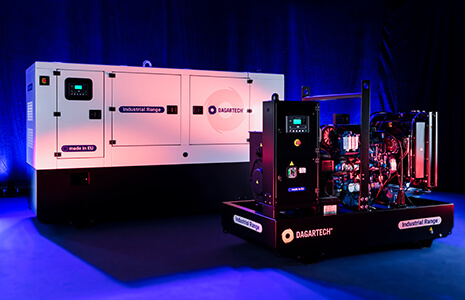- Derating is a phenomenon by which generator sets present losses of power in extreme conditions of temperature, altitude or humidity.
- Studying the environmental conditions that will surround the generator set will be crucial to guaranteeing the suitability of the generator for a specific application.
The arrival of summer and rising temperatures has a serious impact on people’s daily lives, especially during a heatwave like we have had in recent weeks in Spain.
The high temperatures also affect the performance of essential equipment for the proper operation of critical structures and installations. Few solutions are as important as generator sets. These devices are the safety net that keep hospitals, data processing centres and large factories running, among other installations.
Their most common function is that of guaranteeing the electricity supply if the electrical grid fails or becomes unstable. Therefore, knowing the optimal operating conditions and limits of these machines is essential for being able to ensure that the energy demands of an installation can be guaranteed without issues.
At Dagartech, we are specialists in customised energy solutions, and have extensive experience in undertaking projects for multiple fields of application and critical installations. Below, we analyse how the intervention of environmental factors may affect the performance of generator sets and explain what power derating is, a feared enemy of generator sets at high temperatures.
Derating due to temperature in generator sets
Generator sets can deliver all their power when operating under standard environmental conditions[1].
Thus, their performance may show alterations outside of certain ranges of altitude, humidity and temperature.
In extreme temperature conditions, exceeding 40ºC, engines show significant power losses. Above this threshold, air quality is no longer optimal for undertaking proper combustion, which leads to a loss of power of around 10% for every 10ºC of temperature above 40ºC.
Engine manufacturers declare these losses through derating curves, so that they can predict the real power losses that will occur under certain temperature conditions.
Additionally, above 40ºC, the radiator has trouble releasing the heat given off by the engine. It may therefore be necessary to oversize the radiator, and of course, opt for radiators suitable for use in high temperatures, designed for working temperatures of up to 50ºC.
The alternator is another key element of the generator. It also suffers the effects of extreme temperatures. Manufacturers provide correction factors above 40ºC, marking them every 5ºC of temperature increase up to 60ºC.
[1] The ISO 8528 standard establishes standard reference conditions for calculation of the nominal output temperature of the generator set: a total barometric pressure of 100 kPa; an ambient air temperature (Tr) 298 K (25°C); and relative humidity (Ør) of 30%.
Altitude, a very stable, and also very critical factor
Altitude is a truly critical factor. At higher altitudes there is less oxygen in the atmosphere, accompanied by lower pressure. This circumstance especially effects engines without turbos, as the reduced pressure impedes the entry of hot air reaching the intake, reducing the quantity of oxygen available for combustion.
The loss of power for naturally aspirated engines is usually 10% for every 1000 metres above sea level. In the case of turbocharged engines, the loss of power is significantly less.
In the same way, the alternator also suffers the effects of altitude. In this case, losses of power due to altitude occur from 1000 metres above sea level. Manufacturers provide us with correction factors every 500 metres from the aforementioned 1000 metres.
Humidity and its effects on the power of the generator
Humidity is another factor that affects the performance of a generator set. For it to produce truly significant power losses, high levels of humidity must be combined with considerably high temperatures – above 25ºC.
Encountering high temperature and humidity levels at the same time is not common, although these are conditions which may occur in locations with tropical climates.
With regard to alternators, their manufacturers do not indicate power losses due to humidity, although they can be affected by corrosion or suffer short circuits due to condensation of water vapour in the windings of the alternator. Therefore, in atmospheres especially affected by humidity, alternators must be equipped with anti-condensation resistors. In this way, the windings will remain at a sufficient temperature when the generator is not operating and condensation of water will be avoided. If there are also special impregnations, the durability of the alternator will also be maximised.
The importance of the forecast
Derating is a phenomenon which must be addressed whenever environmental conditions are extreme.
It is therefore vital to study the environmental conditions of the location where the generator set will be installed in advance. In this way, we can correctly scale the power of the generator and guarantee the supply. Oversizing the generator set without undertaking a detailed analysis of these power losses is not a professional proposal. In addition to proposing an inefficient solution and incurring unnecessary costs, scenarios may occur where operation at low power jeopardises the proper operation of the machine in the long-term.
Furthermore, undertaking the installation of the generator in locations where temperature and relative humidity levels remain within acceptable thresholds for as long as possible will facilitate optimal operation of the machine.
Entrusting the study of critical installations to professionals will be the key that will guarantee the success of the project, avoiding surprises and setbacks which are difficult to solve and expensive.
About Dagartech
Dagartech is a Spanish company specialised in offering customised energy solutions. In this way, the company stands out for promoting unique projects that demand the maximum level of customisation, as well as designing, manufacturing and commercialising a large number of standard generator set products with powers ranging from 3 kVA to 2,000 kVA.
Dagartech generator sets are always developed considering the target application, the machine’s circumstances of use, the latest advances of the power generation market and the demands of clients. Therefore, with a clear orientation toward the needs of our clients, Dagartech has established itself as one of the main manufacturers of the Spanish market. The company currently has a stable presence in over 30 countries, with exports making up the main volume of its business.
The company has committed to innovation and has built up a human team with extensive experience in the energy generation sector. Quality and excellence form part of its present and pave the way for its future, which involves the company being certified on compliance with the requirements of the ISO 9001:2015 standard.



